Optimal Choice of Soil Hydraulic Parameters for Simulating the Unsaturated Flow: A Case Study on the Island of Miyakojima, Japan
Abstract
:1. Introduction
2. Materials and Methods
2.1. Study Site
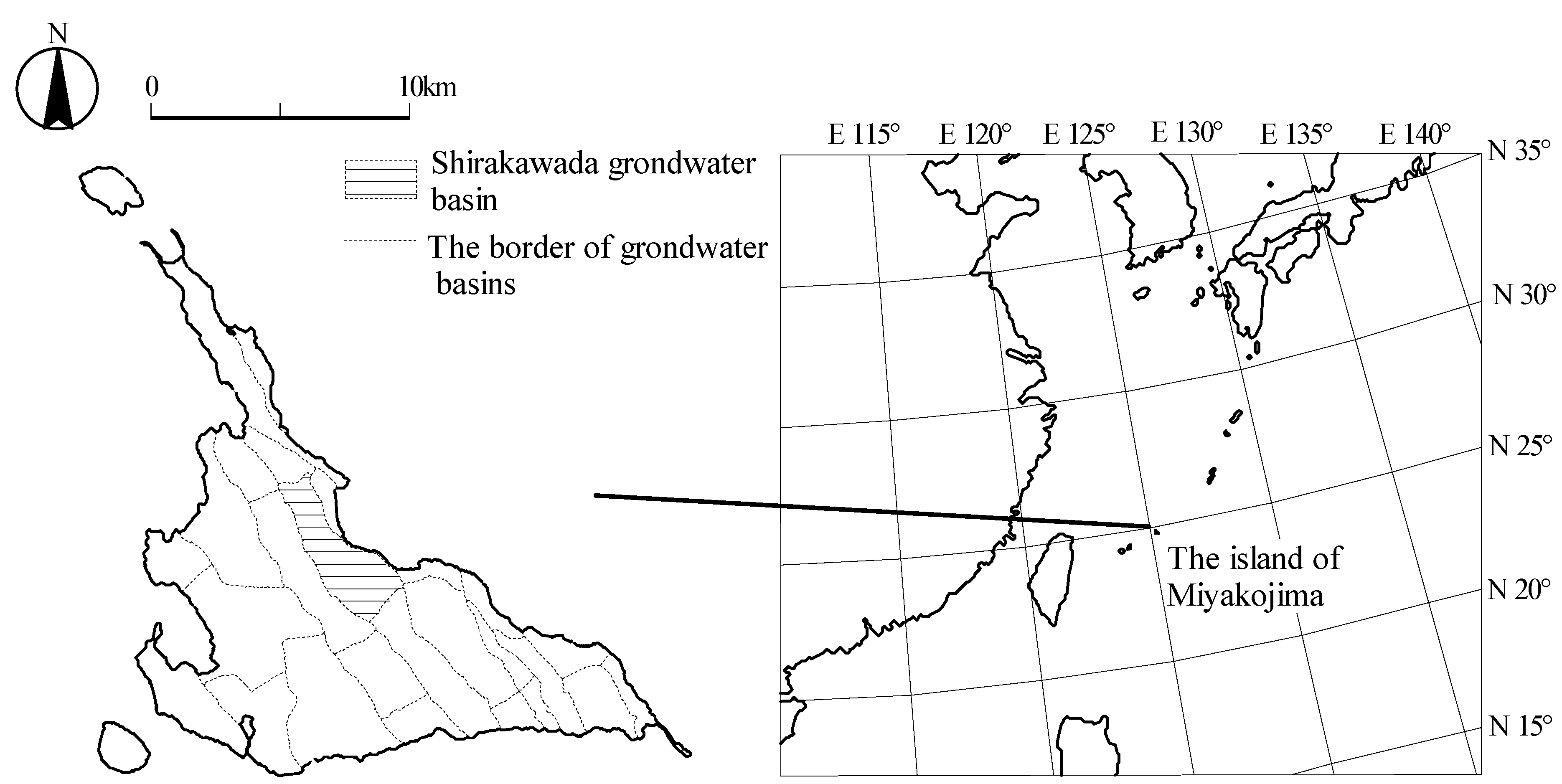
| Method | Log10 [ Suction (cm) ] | |||||||||||||||||||
|---|---|---|---|---|---|---|---|---|---|---|---|---|---|---|---|---|---|---|---|---|
| 1.0 | 1.5 | 2.0 | 2.5 | 3.0 | 3.5 | 4.0 | 4.5 | 5.0 | ||||||||||||
| Hanging water column | ||||||||||||||||||||
| Pressure plate | ||||||||||||||||||||
| Psychrometer * | ||||||||||||||||||||
2.2. HYDRUS-1D
2.2.1. Overview of HYDRUS-1D
2.2.2. Crop Model in HYDRUS-1D

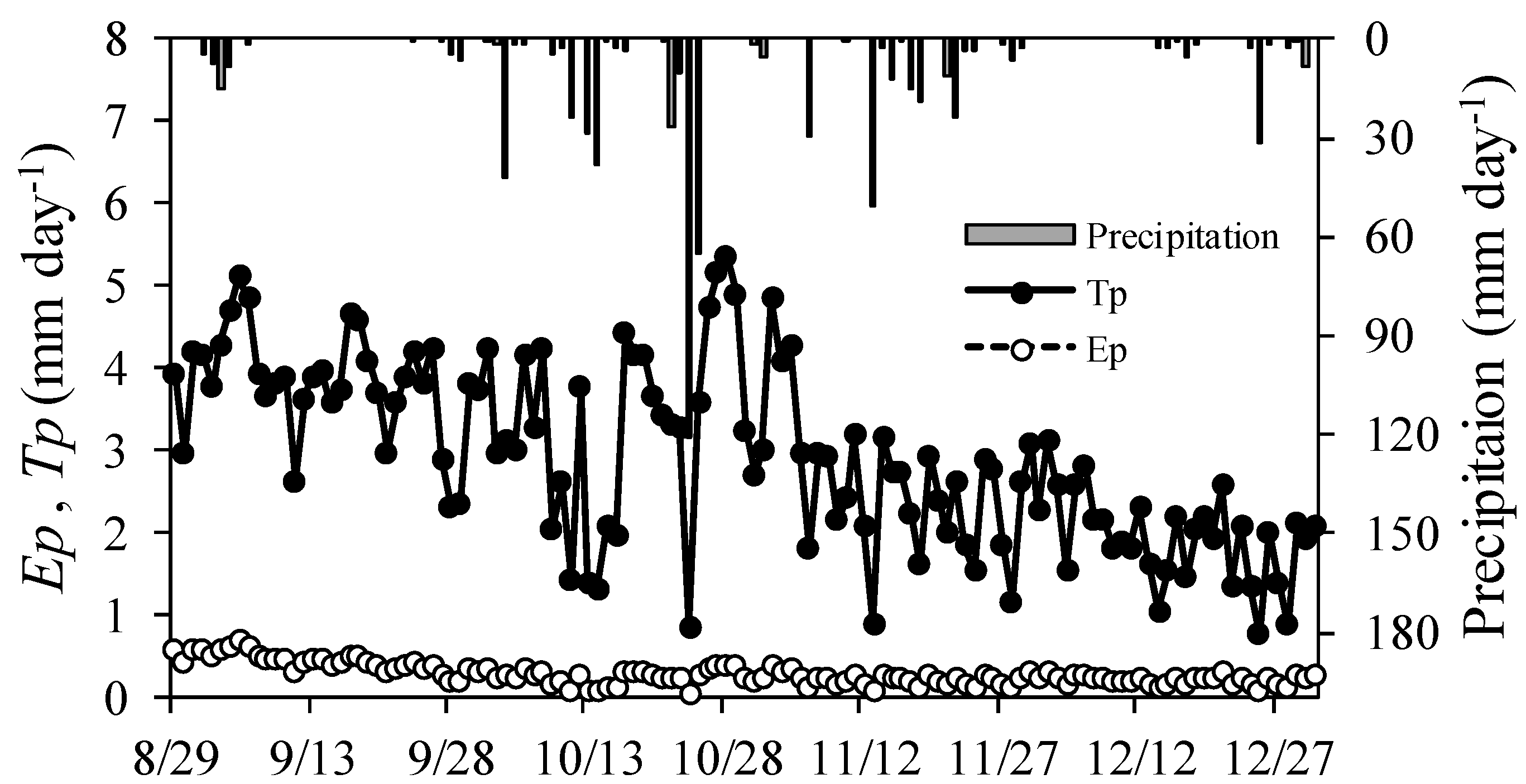
2.3. Comparison of Measured Soil Hydraulic Parameters with Those Estimated Using ROSETTA
| z | Sand | Silt | Clay | Bulk Density | Saturated Conductivity, Ks |
|---|---|---|---|---|---|
| (cm) | (%) | (%) | (%) | (g·cm−3) | Geometric mean ± SD (cm·day−1) |
| 15 | 13.1 | 69.6 | 17.3 | 1.319 | 24.7 ± 97.8 |
| 30 | 11.1 | 71.2 | 17.7 | 1.278 | 24.3 ± 152.6 |
| 50 | 7.5 | 75.3 | 17.2 | 1.268 | 21.8 ± 90.0 |
| 70 | 8.7 | 74.8 | 16.5 | 1.305 | 116.3 ± 343.8 |
| 100 | 10.4 | 70.3 | 19.4 | 1.159 | 21.9 ± 99.8 |
| Soil Hydraulic Parameter | Case 1 | Case 2 | Case 3 | Case 4 |
|---|---|---|---|---|
| Retention curve | Measured | ROSETTA | ROSETTA | Measured |
| Hydraulic conductivity | Measured | ROSETTA | Measured | ROSETTA |
2.4. Simulation of Evapotranspiration and Volumetric Water Contents
3. Results and Discussion
3.1. Comparison of Measured Soil Hydraulic Parameters with Those Estimated by ROSETTA
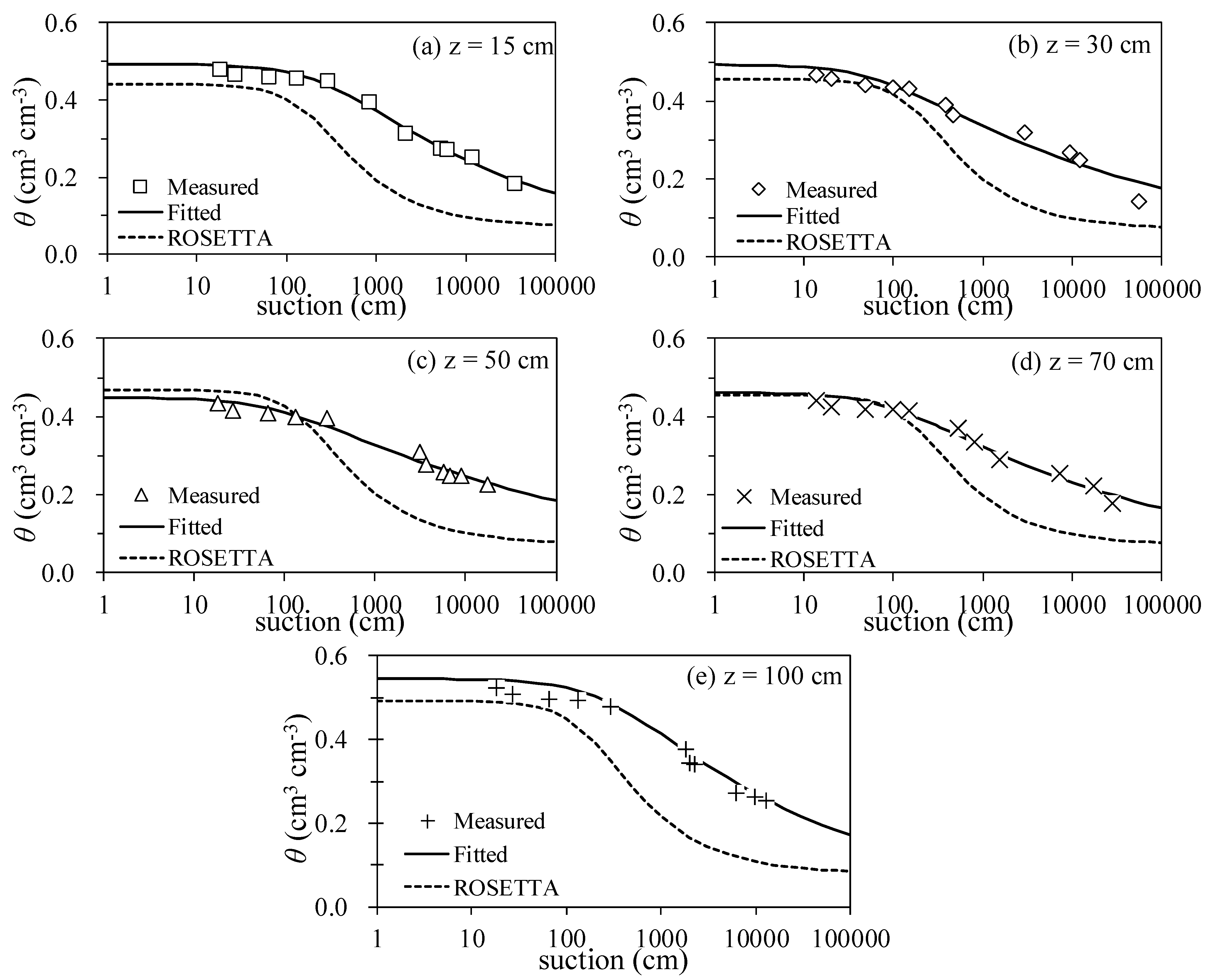
| z (cm) | θr (cm3·cm−3) | θs (cm3·cm−3) | α (cm−1) | n | Ks (cm·d−1) | |||||
|---|---|---|---|---|---|---|---|---|---|---|
| Fitted | ROS | Fitted | ROS | Fitted | ROS | Fitted | ROS | Measured | ROS | |
| 15 | 0 | 0.070 | 0.493 | 0.441 | 0.0037 | 0.0049 | 1.193 | 1.685 | 24.7 | 30.3 |
| 30 | 0 | 0.073 | 0.493 | 0.456 | 0.0148 | 0.0049 | 1.140 | 1.683 | 24.3 | 35.0 |
| 50 | 0 | 0.074 | 0.449 | 0.469 | 0.0117 | 0.0051 | 1.125 | 1.672 | 21.8 | 35.2 |
| 70 | 0 | 0.072 | 0.462 | 0.456 | 0.0107 | 0.0050 | 1.147 | 1.677 | 116.3 | 32.3 |
| 100 | 0 | 0.078 | 0.556 | 0.492 | 0.0082 | 0.0049 | 1.166 | 1.675 | 21.9 | 53.5 |
3.2. Simulation of Evapotranspiration and Volumetric Water Contents
3.2.1. Optimization of h50 and Simulation of Evapotranspiration
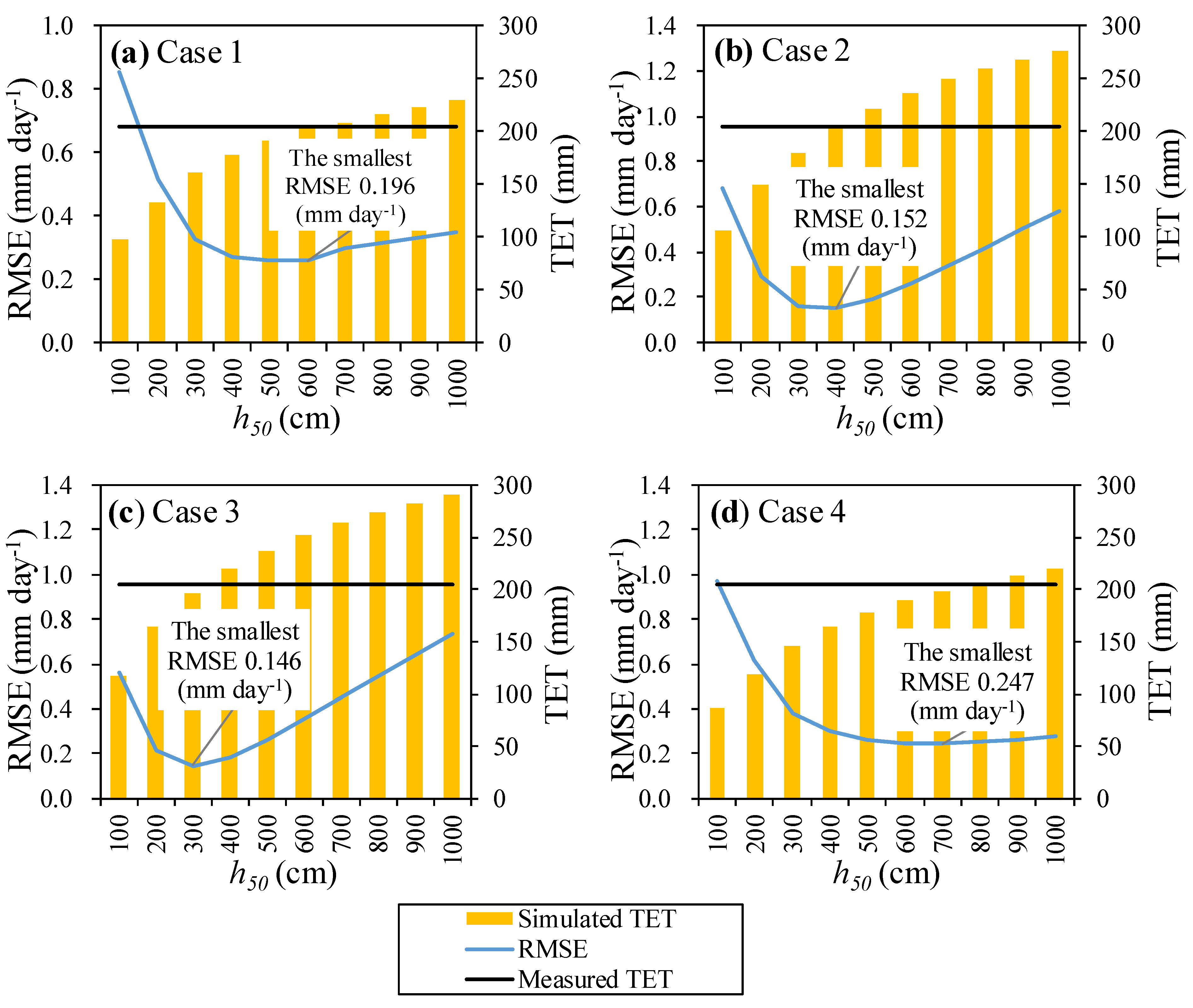
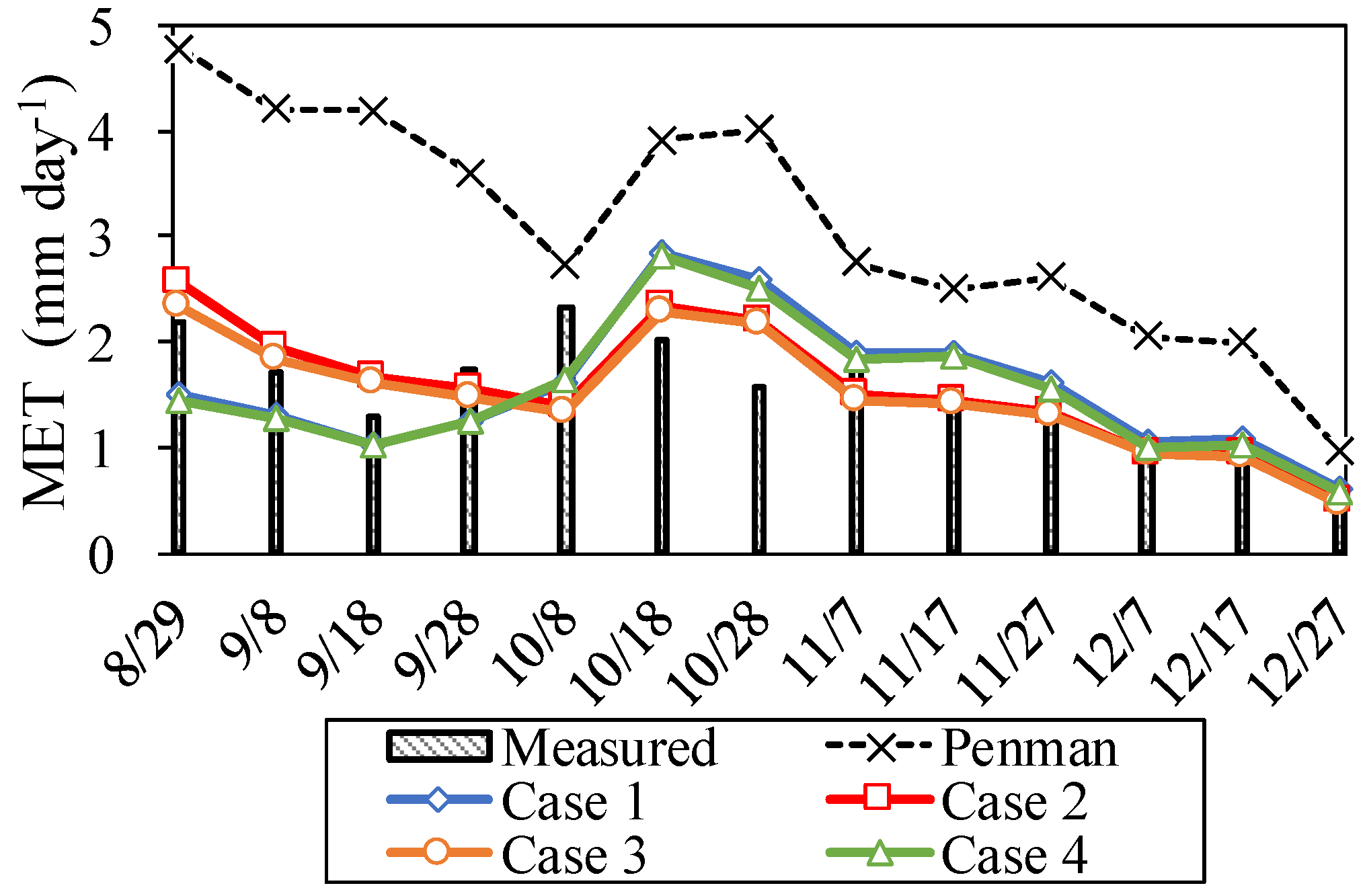
3.2.2. Influence of Soil Hydraulic Parameters on Volumetric Water Contents Simulation
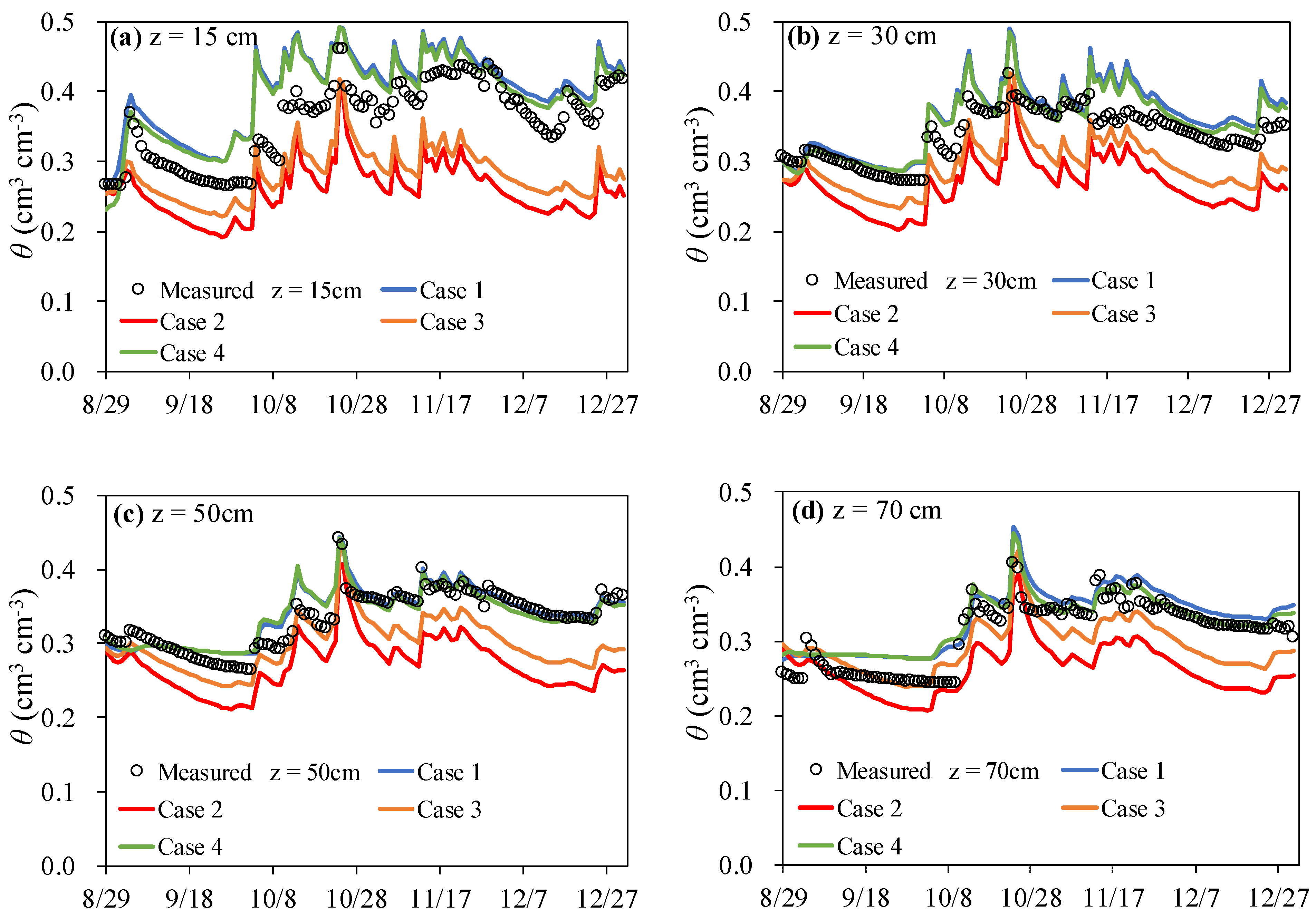
| z (cm) | RMSE (cm3·cm−3) | |||
|---|---|---|---|---|
| Case 1 | Case 2 | Case 3 | Case 4 | |
| 15 | 0.052 | 0.101 | 0.083 | 0.043 |
| 30 | 0.035 | 0.067 | 0.047 | 0.028 |
| 50 | 0.017 | 0.060 | 0.040 | 0.017 |
| 70 | 0.026 | 0.051 | 0.031 | 0.021 |
4. Conclusions
- 1)
- ROSETTA software underestimated measured VWCs.
- 2)
- Optimized values of h50 were dependent on the parameters defined by the retention curve. Simulated and measured total evapotranspiration rates agreed well for all four cases considered. Since, for normal growth the amount of suction required to deplete VWCs is about 1000 cm, we consider the h50 values we obtained that were closest to 1000 cm to be the more realistic. Thus, our HYDRUS-1D simulations using the measured soil hydraulic parameters provided better results than those based on parameters estimated by ROSETTA.
- 3)
- VWCs simulated by HYDRUS-1D using parameters estimated by ROSETTA were lower than the measured values, whereas those using measured parameters agreed well with measured values.
Acknowledgements
Author Contributions
Conflicts of Interest
References
- Climate Change and Its Impacts in Japan. Available online: https://www.env.go.jp/en/earth/cc/report_impacts.pdf (accessed on 4 September 2015).
- Ficklin, D.L.; Luedeling, E.; Zhang, M. Sensitivity of groundwater recharge under irrigated agriculture to changes in climate, CO2 concentrations and canopy structure. Agric. Water Manag. 2010, 97. [Google Scholar] [CrossRef]
- Leterme, B.; Mallants, D.; Jacques, D. Sensitivity of groundwater recharge using climatic analogues and HYDRUS-1D. Hydrol. Earth Syst. Sci. 2012, 16. [Google Scholar] [CrossRef]
- Šimůnek, J.; Šejna, M.; Saito, H.; van Genuchten, M.T. The HYDRUS-1D Software Package for Simulating the One-Dimensional Movement of Water, Heat, and Multiple Solutes in Variably-Saturated Media; Department of Environmental Science, University of California Riverside: Riverside, CA, USA, 2013. [Google Scholar]
- Zlotnik, V.A.; Wang, T.; Nieber, J.L.; Šimunek, J. Verification of numerical solutions of the Richards equation using a traveling wave solution. Adv. Water Resour. 2007, 30, 1973–1980. [Google Scholar] [CrossRef]
- Saito, H.; Šimůnek, J.; Mohanty, B.P. Numerical analysis of coupled water, vapor, and heat transport in the vadose zone. Vadose Zone J. 2006, 5. [Google Scholar] [CrossRef]
- Kato, C.; Nishimura, T.; Imoto, H.; Miyazaki, T. Predicting soil moisture and temperature of andisoils under a monsoon climate in Japan. Vadose Zone J. 2011, 10, 541–551. [Google Scholar] [CrossRef]
- Stenitzer, E.; Diestel, H.; Zenker, T.; Schwartengräber, R. Assessment of capillary rise from shallow groundwater by the simulation model SIMWASER using either estimated pedotransfer functions or measured hydraulic parameters. Water Resour. Manag. 2007, 21, 1567–1584. [Google Scholar] [CrossRef]
- Wang, T.; Zlotnik, V.A.; Šimunek, J.; Schaap, M.G. Using pedotransfer functions in vadose zone models for estimating groundwater recharge in semiarid regions. Water Resour. Res. 2009, 45. [Google Scholar] [CrossRef]
- Van Genuchten, M.T. A closed-form equation for predicting the hydraulic conductivity of unsaturated soils. Soil Sci. Soc. Am. J. 1980, 44, 892–898. [Google Scholar] [CrossRef]
- Wang, T.; Franz, T.E.; Zlotnik, V.A. Controls of soil hydraulic characteristics on modeling groundwater recharge under different climatic conditions. J. Hydrol. 2015, 521. [Google Scholar] [CrossRef]
- Okamoto, K.; Sakai, K.; Cho, H.; Nakamura, S.; Nakandakari, T. Influences of a bulk density for hydraulic conductivity and water retention curve of Shimajiri maji soil, and examination of PTFs’ applicability. J. Rainwater Catchment Syst. 2015, 21, 1–6, (In Japanese with English Abstract). [Google Scholar]
- Miyamura, N.; Iha, S.; Gima, Y.; Toyota, K. Factors limiting organic matter decomposition and the nutrient supply of soils on the Daito Ilands. Soil Microorg. 2011, 65, 119–124. [Google Scholar]
- Classification of cultivated soils in Japan. Available online: http://soilgc.job.affrc.go.jp/Document/Classification.pdf (accessed on 4 September 2015).
- Schaap, M.G.; Leiji, F.J.; van Genuchten, M.T. Neural network analysis for hierarchical prediction of soil water retention and saturated hydraulic conductivity. Soil Sci. Soc. Am. J. 1998, 62, 847–855. [Google Scholar] [CrossRef]
- Schaap, M.G.; Leiji, F.J. Improved prediction of unsaturated hydraulic conductivity with the Mualem-van Genuchten model. Soil Sci. Soc. Am. J. 2000, 64, 843–851. [Google Scholar] [CrossRef]
- Schaap, M.G.; Leiji, F.J.; Van Genuchten, M.T. Rosetta: A computer program for estimating soil hydraulic parameters with hierarchical pedotransfer function. J. Hydrol. 2001, 251, 163–176. [Google Scholar] [CrossRef]
- Kosugi, Y.; Katsuyama, M. Evapotranspiration over a Japanese cypress forest. II. Comparison of the eddy covariance and water budget methods. J. Hydrol. 2007, 334, 305–311. [Google Scholar] [CrossRef]
- Jayasinghe, G.Y.; Tokashiki, Y.; Kitou, M.; Kinjyo, K. Effect of synthetic soil aggregates as a soil ameliorant to enhance properties of problematic gray (“Jahgaru”) soils in Okinawa, Japan. Commun. Soil Sci. Plant Anal. 2010, 41, 649–664. [Google Scholar] [CrossRef]
- Mualem, Y. A new model predicting the hydraulic conductivity of unsaturated porous media. Water Resour. Res. 1976, 12, 513–522. [Google Scholar] [CrossRef]
- Van Genuchtenm, M.T. A Numerical Model for Water and Solute Movement in and Below the Root Zone; U.S. Salinity Laboratory, USDA, ARS, Riverside: CA, USA, 1987. [Google Scholar]
- Van Genuchten, M.T.; Gupta, S.K. A reassessment of the crop tolerance response function. Indian Soc. Soil. Sci. 1993, 41, 730–737. [Google Scholar]
- Smith, D.M.; Inman-Bamber, N.G.; Thorburn, P.J. Growth and function of the sugarcane root system. Field Crops Res. 2005, 92, 169–183. [Google Scholar] [CrossRef]
- Larsbo, M.; Jarvis, N. MACRO 5.0: A Model of Water Flow and Solute Transport in Macroporous Soil; Department of Soil Sciences, Swedish University of Agricultural Sciences: Uppsala, Sweden, 2003. [Google Scholar]
- Nakama, M.; Nose, A.; Miyazato, K.; Murayama, S. The Science Bulletin of the Faculty of Agriculture, University of the Ryukyus, 1st ed.; Faculty of Agriculture, University of the Ryukyus: Naha-shi, Japan, 1987; pp. 187–198. [Google Scholar]
- Penman, H.L. Natural evaporation from open water, bare soil and grass. Proc. R. Soc. Lond. A 1948, 193, 120–145. [Google Scholar] [CrossRef]
- Miura, T.; Okuno, R. Detailed description of calculation of potential evapotranspiration using the Penman equation. Trans. Jpn. Soc. Irrig. Drain Reclam Eng. 1993, 164, 163. [Google Scholar]
- Campbell, G.S. Soil Physics with Basics, Transport Models for Soil-Plant Systems, 1st ed.; Elsever: New York, UN, USA, 1985; p. 144. [Google Scholar]
- Schaap, M.G.; Leiji, F.J. Database-related accuracy and uncertainty of pedotransfer functions. Soil Sci. 1998, 163, 765–779. [Google Scholar] [CrossRef]
- Yanagawa, A.; Fujimaki, H. Tolerance of canola to drought and salinity stresses in terms of root water uptake model parameters. J. Hydrol. Hydromech. 2013, 61, 73–80. [Google Scholar] [CrossRef]
© 2015 by the authors; licensee MDPI, Basel, Switzerland. This article is an open access article distributed under the terms and conditions of the Creative Commons Attribution license (http://creativecommons.org/licenses/by/4.0/).
Share and Cite
Okamoto, K.; Sakai, K.; Nakamura, S.; Cho, H.; Nakandakari, T.; Ootani, S. Optimal Choice of Soil Hydraulic Parameters for Simulating the Unsaturated Flow: A Case Study on the Island of Miyakojima, Japan. Water 2015, 7, 5676-5688. https://doi.org/10.3390/w7105676
Okamoto K, Sakai K, Nakamura S, Cho H, Nakandakari T, Ootani S. Optimal Choice of Soil Hydraulic Parameters for Simulating the Unsaturated Flow: A Case Study on the Island of Miyakojima, Japan. Water. 2015; 7(10):5676-5688. https://doi.org/10.3390/w7105676
Chicago/Turabian StyleOkamoto, Ken, Kazuhito Sakai, Shinya Nakamura, Hiroyuki Cho, Tamotsu Nakandakari, and Shota Ootani. 2015. "Optimal Choice of Soil Hydraulic Parameters for Simulating the Unsaturated Flow: A Case Study on the Island of Miyakojima, Japan" Water 7, no. 10: 5676-5688. https://doi.org/10.3390/w7105676
APA StyleOkamoto, K., Sakai, K., Nakamura, S., Cho, H., Nakandakari, T., & Ootani, S. (2015). Optimal Choice of Soil Hydraulic Parameters for Simulating the Unsaturated Flow: A Case Study on the Island of Miyakojima, Japan. Water, 7(10), 5676-5688. https://doi.org/10.3390/w7105676





